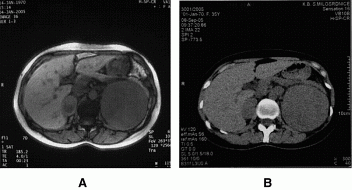ICEECE2012 Poster Presentations Endocrine tumours and neoplasia (112 abstracts)
Antiproliferative effect and control of catecholamine release with octreotide in a patient with giant bilateral pheochromocytoma
D. Katalinic 1 , S. Plestina 1 , M. Vrkljan 2 , I. Aleric 1 & A. Maric 2
1University Hospital Centre (KBC Zagreb), University of Zagreb School of Medicine, Zagreb, Croatia; 2University Hospital Centre ‘Sisters of Charity’, University of Zagreb School of Medicine, Zagreb, Croatia.
Introduction: Pheochromocytomas are rare but treacherous catecholamine-producing tumors of the medulla of the adrenal glands (originating in the chromaffin cells), or extra-adrenal chromaffin tissue. We refer a case with stabilization of tumor growth and hormonal improvements following repeated s.c. injections of octreotide.
Case report: We report a female patient aged 35 with a finding of bilateral adrenal mass with sever cardiovascular symptomatology (frequent paroxysms of headache and palpitations accompanied with hypertensive episodes). Biochemical screening showed 20-times higher level of adrenalin, 13-times higher level of noradrenalin, 27-times higher level of chromogranin A and 30-times higher level of vanillylmandelic acid in 24 h urine. Enhanced MR imaging (Fig. 1A) confirmed the findings of adrenal gland tumors (the left adrenal mass was 11×9 cm, and right adrenal mass was 4×3 cm in size). I-131-MIBG scintigraphy showed uptake in both adrenal glands. As a member of the Jehovah’s Witnesses, the patient refused surgery definitively not accepting a possibly needed blood transfusion, but was successfully treated with octreotide at 50 μg s.c. injection twice daily during 2.5 years with relief of symptoms and tumor shrinkage on enhanced MSCT scan (Fig. 1B). We also observed a significant reduction in catecholamines and chromogranin A levels.
Conclusion: We stress the importance of complete hormonal screening in all cases of adrenal masses, especially in patients with cluster of heart symptoms. Pheochromocytomas are best treated surgically to obviate the associated dangerous cardiovascular catecholamine-mediated paroxysmal events. However, successful treatment with somatostatin analogues such as octreotide could be potentially considered as the treatment of choice for patients with pheochromocytoma especially those considered unsuitable for surgery or in cases where the operation is not possible.
Declaration of interest: The authors declare that there is no conflict of interest that could be perceived as prejudicing the impartiality of the research project.
Funding: This research did not receive any specific grant from any funding agency in the public, commercial or not-for-profit sector.

Figure 1 (A) Abdominal MR imaging: giant bilateral adrenal pheochromocytoma (left adrenal tumor: 11×9 cm; right adrenal tumor: 4×3 cm in size). (B) Abdominal MSCT: bilateral pheochromocytoma with a partially necrotic zones during octreotide treatment.
 }
}



